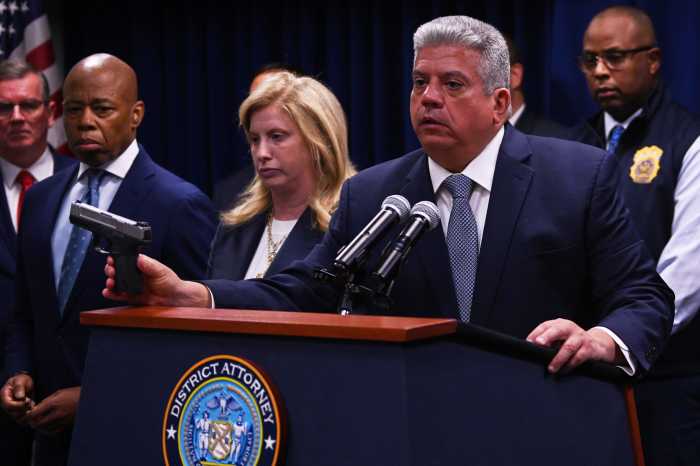State Senator Daniel Squadron announced last week a proposal to reallocate $369,000 in State Liquor Authority (SLA) funding to allow the agency to jump start a critical technology upgrade, resulting in significant cost savings and revenue increases for the state, increased transparency, and streamlined processing for liquor license applications.
If approved, the funding will help provide the SLA with an e-licensing system, decreasing the time required to approve a license and eliminating the SLA’s now-notorious backlog of applications. It will also create a state-of-the-art Web site, enabling New Yorkers to be better informed and more engaged in SLA issues affecting their communities.
“Funding the SLA’s technology upgrade is a common-sense investment that will result in a huge payoff,” the Brownstone Brooklyn lawmaker said.
Five new luxury condominiums, all one-bedrooms at the 16-unit Locale in Greenpoint, sold on November 11 in Sheldon Good & Company’s auction held at the New York Marriott in Downtown Brooklyn.
The event represented the first offering of luxury condos to be sold at auction New York City in over a decade. Four condos were sold absolute (meaning to the highest bidder), as offered by the co-seller/developers TreeTop Development and aptsandlofts.com, and a fifth condo was sold with reserve (meaning a property cannot be sold unless the bidding meets or exceeds a set amount).
The highest price attained for one of the five condominiums was $426,000.Offers were made after the bidding as well.
“We are very pleased with the results of the Locale auction,” said Adam Mermelstein, General Partner of TreeTop Development.“It achieved two of our goals, one was making the offering plan for The Locale effective, since we succeeded in selling the requisite number ofunits to begin conventional sales; and secondly, focusing buyers on this property. “
Hundreds of city and state housing advocates %u2013 many from the borough %u2013 assembled at City Hall last week to demand that Governor David Paterson doesn’t forget city housing developments when he takes a knife to the state budget to close the $3.2 billion budget deficit.
In a rally organized by Brooklyn Heights State Senator Daniel Squadron, members of Save Our Underfunded NYCHA Developments (SOUND) Housing campaign, calling for full funding in the 2010 budget.
Despite the city and state’s grim financial situation, SOUND wants to make sure that the two legislative bodies fully fund $64 million for state-built developments, fully fund $30 million for city-built developments, stop requiring NYCHA to pay more than $70 million for police and sanitation services; and invest $100 million from the Federal stimulus package in weatherization of NYCHA developments.
There are 336 NYCHA-run housing developments in the city. A hundred of them are located in Brooklyn.
Squadron noted that more than 1 in 20 New Yorkers live in NYCHA buildings.
“For a decade, the State has shamefully turned its back on its obligation to these New Yorkers. NYCHA needs basic resources to provide services for its residents, and the State and City must step up with the funding they owe to allow that to happen,” said Squadron.
Assemblymember Vito Lopez, who chairs the Assembly Housing Committee, agreed, adding that public housing is “the lifeline for hundreds of thousands of hardworking people” in the city.
“We will fight for our residents and the proper maintenance of their quality of life. We will not back down until NYCHA gets the funding it deserves,” said Lopez.
Southern Brooklyn is slowly becoming a city heavyweight %u2013 but not in a good way, according to a new report by the city’s Department of Health and Mental Hygiene.
Using 2007 U.S. census data as their guide, officials said that Canarsie, Flatlands, Mill Basin, Mill Island, Bergen Beach and Flatbush, as well as East New York, Bushwick, Bedford Stuyvesant and Greenpoint have the highest number of obesity cases in the borough.
The information, derived from a map in a report that diabetes has increased from eight percent in 2002 to nine percent in 2007, explains that 27 to 39 percent of residents in these neighborhoods are either obese. Neighborhoods with the highest number of diabetes cases can be found in central Brooklyn, namely Flatbush, East Flatbush, Brownsville and Bushwick.
Downtown Brooklyn, Brooklyn Heights, Park Slope, Sunset Park and Williamsburg, housed the thinnest borough residents with less than 18.5 percent of them identified as obese.
Once upon a time we relied on good ‘ol Johnny Appleseed to lay down fresh roots for us, today we’ve got 311.
The New York City Department of Parks and Recreation has a goal of planting 20,000 new street trees in the coming year and they want your help to get the job done.
Neighborhood residents who want to green up their block are being encouraged to call 311 and order a tree.
Officials say that if you don’t call, new trees will only go to somebody else’s block.
The Parks Department is already trying to place new trees in neighborhoods shown to have low tree canopies and high rates of asthma.
So, act now.
The city Education Department’s Panel for Educational Policy has ended social promotion for grades four and six.
Under the new rules, students in grades four and six who receive Level One scores on the state’s standardized English and math exams will be held back. However, if the students attend summer school for “intensive remedial support” and re-take and pass the exams, they will be promoted.
Grades three, five, seven and eight already maintain this policy, which is intended to end social promotion, the common practice of sending students to the next grade regardless of their ability to master the curriculum or obtain basic skills.
Representatives for the city Department of Social Services are attending local civic association meetings to encourage low-income Brooklynites to apply for food stamps.
Eligibility to receive benefits is based on household size, income and some household expenses.
Visit www.nyc.gov/html/hra to use a “Food Stamp Calculator” to determine if your family is eligible for assistance.
For more information about applying for food stamps, call 1-800-342-3009 or 311.
New York State has kicked off its effort to make sure that all of its residents are counted during the 2010 Census.
The Census, which occurs every decade, has significant implications for localities such as Brooklyn, because both federal representation and the share of federal funding for such necessities as schools, housing, roads and hospitals are determined by it.
Thus, local elected officials have already jumped on the bandwagon, urging residents to fill out the Census forms they receive.
Statewide, according to Governor David Paterson, more than 202,000 people were not counted in the 2000 Census.With as much as $400 billion in federal funding allocated based on Census data, “We can and must do better,” he contended. To that end, he said, the state has established the Census Complete Count Campaign.
Local elected officials expressed concern that the maximum number of people in their districts be counted.
Brooklyn Representative Yvette Clarke noted that fewer than 35 percent of the residents of the 11th Congressional District, which she represents, responded to the Census in 2000. “An accurate count of all ethnic communities will highlight their purchasing power and economic impact both in the U.S. and global markets, particularly communities that represent a large part of the African Diaspora,” she emphasized.
Representative Nydia Velazquez agreed. “With the 2010 Census, we must put an end to the historical undercount of Hispanic and other minority communities,” Velazquez contended. “A fair and equal count in 2010 will ensure New York’s diverse communities receive vital resources for schools, health care, job training and infrastructure.”
April 1, 2010 is National Census Day. Prior to that, in March, the United States Postal Service will deliver questionnaires to households. Census forms will also be available in March and April at a variety of public locations, for those households that did not receive one. Follow-up will be conducted through August, 2010, to make sure that as many people are counted as possible.
A key fact is that personal information collected through the Census is not shared with other governmental entities, emphasized State Senator John Sampson.
“We want to remind our neighbors their privacy will be protected,” he stressed.“It doesn’t matter if you are not a citizen, or if you have someone living with you the landlord doesn’t know about; the Census is prevented by law from sharing that information.”
To send in tips, e-mail editorial@cnglocal.com attn: Borough Briefs






















